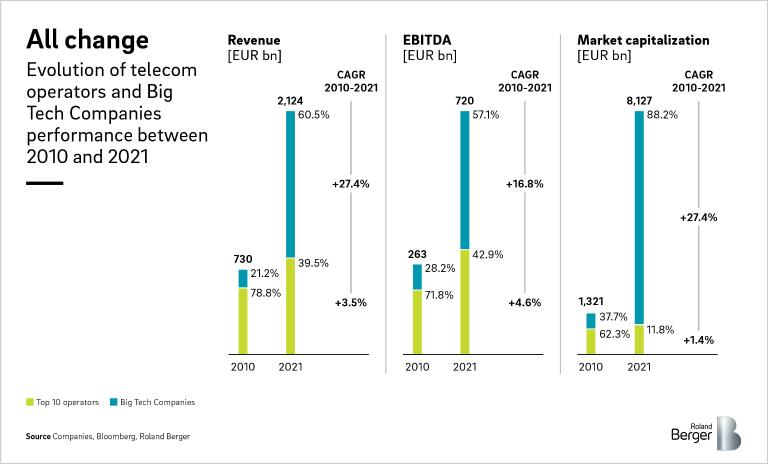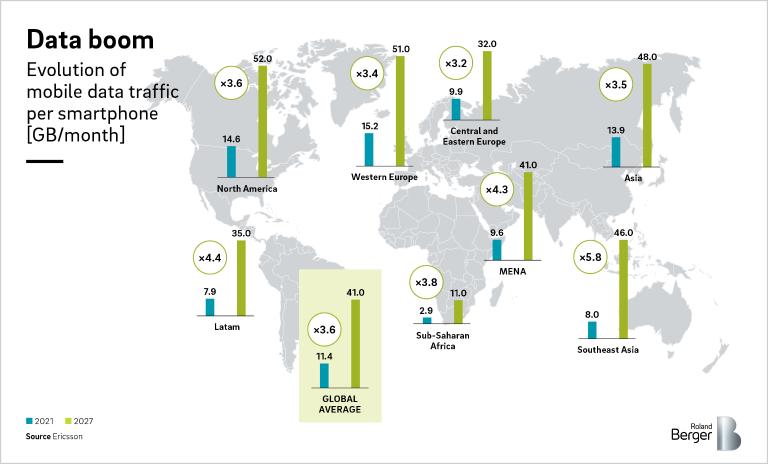Roland Berger is the partner of choice to successfully navigate the TMT industry's complex market dynamics.


Transforming telcos: Opportunities and models for telecom operators
By Didier Levy
A blueprint for growth in the era of ultra-high-speed broadband
After years of growth, telecoms operators are feeling the pinch. Revenues have stagnated, capital expenditure on new networks has soared and big tech has taken a huge bite out of their potential markets. But with enormous value still to leverage, how can telcos face down these challenges and get back on track? Our new study presents some levers and models for future success in telecommunications.

"Given the challenges telecom operators are faced with, they must adapt and pursue new opportunities to regain attractive margins and generate value."
Traditional telecom operators are stagnating or growing slowly. The boom years after the liberalization of the telecommunications industry and digital revolution are long gone, services have shifted online and new, aggressive competitors in the form of big tech and agile start-ups are squeezing markets. Telcos have struggled to adapt to the new reality. Capital expenditures have soared as they keep up with the latest, ultra-fast broadband technology, such as 5G networks and fiber. But with years of experience in communications, huge customer bases and a range of technology assets from telecom towers to fiber networks, telcos clearly still have value to leverage. The question is how?
Our report, Future telecoms: Challenges, growth opportunities and new models in the era of ultra-high-speed broadband, aims to help telcos get back to a growth track. It takes an in-depth look at the issues facing the telecom industry and outlines six key levers to drive up revenues and margins and reshape the telecommunication sector. Using these levers, we recommend three potential models for telecoms players to re-orient their strategic position.
"Global tech-players are a clear threat to established telecom players, as they offer a broad and fast moving scope of services and content."
Challenges
Telecoms operators are currently experiencing the most difficult market conditions on record, and several issues are degrading the sector’s attractiveness. We see two key challenges affecting the future of the telecommunications industry, outlined below and covered in detail in the full report.
First, CAPEX pressures. Average revenues for the top 10 telecoms operators worldwide grew by just 2.7% per annum over the past four years. This sluggish growth coincided with exploding CAPEX requirements, as telcos rolled out several new generations of network, from from 3G/4G to 5G and from copper to fiber, in quick succession.
Second, intense competition from big tech. In 2010, the top 10 telecoms operators generated about four times more revenue and 2.5 times more profit than Google, Apple, Facebook, Amazon and Microsoft. By 2021, the situation had been completely reversed. This shift in telecommunications dominance has severely impacted the market capitalization of telecoms operators.
Opportunities
To overcome these telecom trends and other challenges, telcos must adapt and enable new opportunities to regain attractive margins and generate value. In the full report we present and take an in-depth look at six key levers telcos can use to harness this growth, including industry examples. They are:
- Exploiting growing demand: Ultra-high-speed broadband – fixed and mobile – will become mainstream in the next decade, and global customer data usage will increase by a multiple of four.
- New use cases: No revolutionary consumer use case for 5G networks has yet been developed. New 5G opportunities will emerge in the enterprise space and industrial projects based around 5G networks are being launched around the world.
- Using central position in ecosystem: In the next decade, the telecommunication ecosystem will expand and telcos will have to move beyond their traditional boundaries and deal with a large array of players from multiple industries.
- Targeted M&A: Major market consolidation is expected, driven by telcos and private equity players. Telcos will continue to carve out infrastructure and businesses.
- Accelerating structural changes: Copper decommissioning has started, and softwarization and cloudification of networks and IT will be a critical part of the reinvention of telcos. Artificial intelligence will be a key tool.
- Embracing sustainability: Telecoms operators can generate massive carbon footprint and energy cost-reduction savings by running transversal efficiency programs.
Ultimately, to address the challenges and opportunities of the next decade, telcos need to rethink their strategic and operating models. In the full report, we recommend three strategic models: Connectivity provider (focused on high-quality, data-oriented connectivity), Digital services champion (agile provider of digital telecoms and non-core services) and ICT player (platform-based operating model with multiple partnerships). Each is supported by a set of common enablers, including how to reconfigure assets and digitalize operations.
Together, the models and enablers aim to ensure telcos are not just fit for the future but thrive in it.
Register now to download the full report Future Telecoms.















